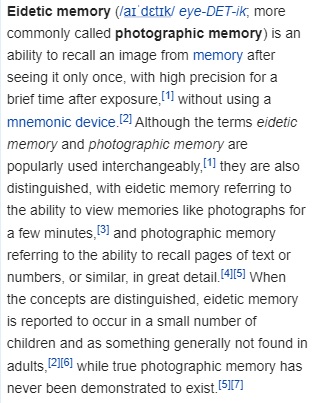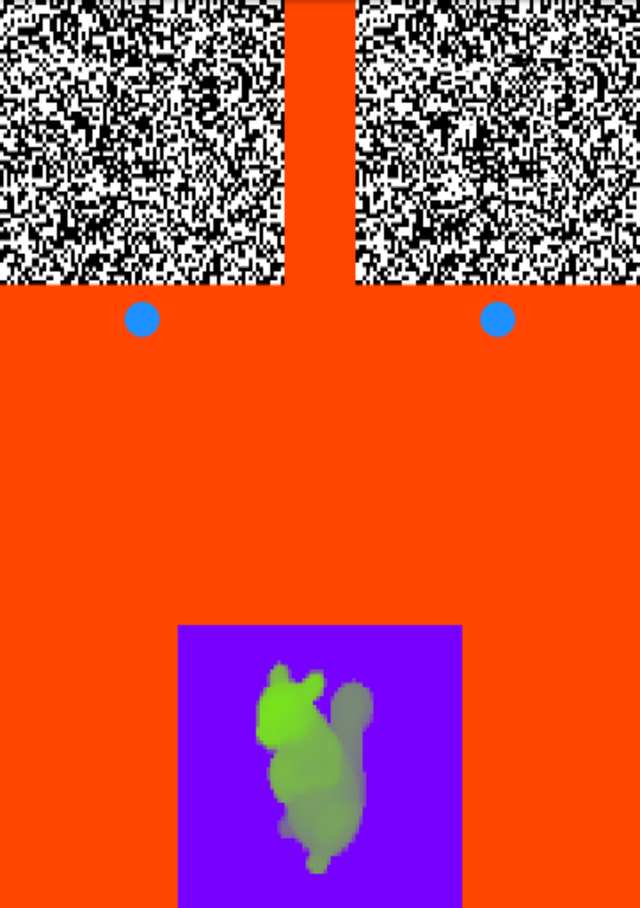
Photographic Memory fully exposed by World Memory Champion
Table of Contents
Does photographic memory exist? The short answer is no. The long answer follows.
Most people reading the headline to this article might feel that the answer must be ‘yes’. Not because they think that they have a photographic memory themselves but because they for sure know at least a few people with this much sought-after ability. And we all do. At least once a month, I find myself speaking with someone after a memory lecture who claims that his or her partner’s cousin or classmate’s nephew or friend’s friend ‘actually has photographic memory’.
Since this trait seems so very common, it might seem absurd to claim that it is all a myth. In that case, it appears, it would have to be one of the most entrenched and deep myths of modern society. Still, there does not exist a single study confirming anyone having a photographic memory. (Or actually, one single study does exist, but more about that in a little bit…)
[Maybe you’re one of the people who genuinely believe that they have a photographic memory? Then read on until you find the ultimate photographic memory test further down the text. If you think you’d pass it, please send us an e-mail immediately!]
A matter of words: Photographic vs. Eidetic
To figure this mystery out, let us start with defining what we mean when we say that someone has a photographic memory. It is necessary to determine the truth in the matter. When you search for ‘photographic memory’ on Wikipedia, you are redirected to a page called ‘Eidetic memory’ that states the following:

There are a bunch of interesting things to observe here. Firstly, there appears to exist two distinct terms related to this kind of memory.
On the one hand, we have eidetic memory, which is a phenomenon that has been confirmed to exist, at least among young children. According to the Stanford Encyclopedia of Philosophy, this means that a small percentage of children can be shown an image for about 30 seconds and immediately afterward describe it in great detail. However, this “mental image” is not perfect and seems to fade away after at most four minutes.
On the other hand, we have what also in science is called a photographic memory, which seems to be more in accordance with what we usually associate with the concept. Here it is not a question of being able to win a game of ‘Look at these ten things, look away, look back, which one have I removed?’ But preferably something much more useful: To have the ability to store detailed mental pictures of text-book pages for not only minutes but weeks and years.
When people talk to me about ‘photographic memory’, the latter definition is always what they have in mind. The stories are commonly about people who only had to read through the books in school once and then aced every test.
This could be achieved by someone very interested in a subject or with just an extraordinarily good memory, but note that this is not what is being said. If that was it, they would just be described as having excellent memories. The word photographic indicates something more.
I believe that most people’s image of someone with an actual photographic memory is that this person can look at, say, a painting or a page of scribbles and instantly store a photocopy of it in his or her head. You could argue that anything less than that is nothing else than “a very good memory”. So let us stick to this last definition. Does or did any such person ever exist? The world’s gathered science says no. With one exception.
The wonder woman and the ultimate photographic memory test
In 1970, the scientist Charles Stromeyer published the results of a study he had conducted on a Harvard student named Elizabeth. This study is the only one throughout history that seems to confirm the existence of photographic memory.
The study is partly available online and very fascinating to read. According to the study, Elizabeth can recall pages of texts containing, for example, a foreign language poem that she read years ago and copy it from bottom to top as fast as she can write. She claims to have used this ability a lot for high-school and undergraduate examinations, but for some reason, she did not find it as useful in graduate school.
The way Stromeyer tests her memory seems very plausible. He is using a stereogram, which is an image composed of two separated patterns (each shown to one eye) that merge into one three-dimensional picture once combined. Such as this:

Stromeyer’s first stereogram consists of two images, each containing 10 000 dots. Elizabeth gets to look at the first image with her right eye for one minute and is given a ten-second break. After that, she is shown the other image to her left eye and asked to recall the first image to create the effect that she is seeing both images simultaneously. She does so and can immediately tell the researchers that she is looking at a T, which is the correct shape produced by the stereogram.
This first part sounds extremely impressive but would still classify more as “eidetic memory” than photographic since she only has to keep the image in her mind for ten seconds.
So Stromeyer raises the bar. In the next experiment, Elizabeth gets to look at another 10 000 dots image with her right eye. This time she looks at it for three minutes, then rests a minute, then looks at it again et cetera until she has seen it for a total of twelve minutes. Twenty-four hours later, she is given the left-eye image and within ten seconds, sees a square, which is correct.
To really top it off, she is also given a million-dot image and manages to keep that in her mind for at least four hours, according to the study.
A spectacular turn of events
Is this then the final proof we were looking for? It seems unreasonable to believe that you could memorize one million dots in any other than a photographic way. However, there is a twist to all of this.
A bit later, Stromeyer and Elizabeth got married.
Such things can of course happen, but what is more suspicious is that Elizabeth thereafter refused to be retested. Studies of her ability obviously would be of tremendous value for the science of memory.
Scientists have continued to look for individuals with a similar skill ever since. One of the most devoted ones was John Merritt who on several occasions during the 70’s put a photographic memory test in major newspapers asking people who succeeded to contact him. Over the years, 30 persons contacted him and he visited several of them, but they never managed to reproduce the results in his presence.
As of today, Elizabeth is the only one who managed to convince a scientist of having a photographic memory, but she appears to have been able to convince him of more than that… So I guess it is fair to say that the great search still goes on.
How come this myth is so accepted?
I can think of a couple of reasons for the widespread notion that photographic memory exists. It has to do with dis-belief in our own abilities, combined with other persons taking advantage of that.
We love genius
One of the most popular characters in Hollywood movies is the genius. This persona is usually characterized by a gigantic brainpower and a fantastic memory. It is rare that these abilities are trained. Most often, the subject was born with them, which is extra evident in the cases where the genius is a child.
Of course, these movies are almost never based on any real science. Just as the action heroes are larger than life, so are the geniuses. But it cements the idea in us all that some people’s brains work in ways very different from our own and that some people have it while others don’t.
This leads us to very quickly buy the idea that someone is a genius without questioning it. It even goes so far that it is challenging to convince someone that you are not a genius.
Every time I am participating in a tv show or an interview, I very much stress the fact that I was not born with a particularly good memory and that I do not have any unusually odd brain. Still, I get messages from people almost every day asking me about what kind of syndrome I have or how it was growing up remembering everything.
And all my fellow memory athletes seem condemned to the same fate. My national team colleague Marwin Wallonius was close to winning Sweden’s got Talent when he memorized the numbers on 1,000 credit cards (plus the PIN codes) in the final show. In the comments on the video of this on YouTube many people ascertain that he was born with a photographic memory, even though he several times during the show mentions that he is using memory techniques.
We prefer impressive skills being unexplainable and mysterious rather than acquired through hard training and publicly available. Maybe it just is more comfortable to believe that we are, or aren’t, born with specific abilities. We don’t have to feel bad about reaching our full potential if we don’t think that we have any.
Alleged people with photographic memory
Since the myth of photographic memory exists, naturally, many people will try exploiting it.
A considerably innocent example is magicians using memory techniques combined with trickery for fooling the audience that they can remember a deck of cards by just glancing at it. No one can, although the current world record – about 12 seconds (achieved through memory techniques) – is truly remarkable. Sometimes these magicians make clear that it is all a trick, but often they don’t.
More alarming are the money-grabbers trying to profit from selling “courses in photographic memory” using completely unscientific methods with no real effects.
Some people use memory techniques but purposely convinces people (and at times even scientists) that they have astonishingly unusual abilities close to photographic memory to get more fame and money then they would have otherwise. Considering the comments on Marwin’s video, this seems a quite simple approach to take… More about this in future articles.
Better than photographic memory training
Now you have read the words “memory techniques” several times, and if you didn’t know about them before, you are probably getting curious. But if I start telling you what it is, you are likely to believe that I am just trying to sell you one myth in place of another.
So instead, I encourage you to try out the memoryOS free trial and judge for yourself.
I want to be clear that what we teach here in no way resembles a photographic memory. You will not be able to briefly look at things and remember them without any effort. That is just not how the brain works.
You will, however, learn how to deliberately choose the things you want to remember and store them safely in your head for as long as you like. You can not remember everything, but you can remember enough to make your life a lot easier, and the people around you very impressed.
It will take a little (joyful) training, but in the end, you will save countless hours by avoiding the all too time-consuming business of forgetting important things.
Just promise me you won’t try to make a career out of fooling everyone that your skills are the result of a photographic memory. Promise? Thanks.
And best of luck!
Jonas von Essen
Two times World Memory Champion